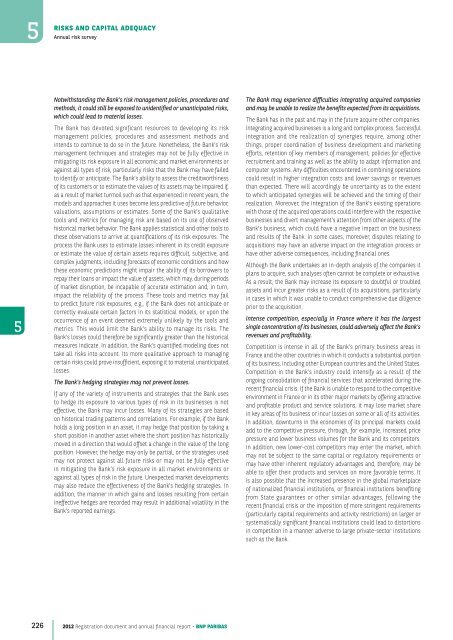2012 Registration document and annual financial report - BNP Paribas
2012 Registration document and annual financial report - BNP Paribas
2012 Registration document and annual financial report - BNP Paribas
- No tags were found...
You also want an ePaper? Increase the reach of your titles
YUMPU automatically turns print PDFs into web optimized ePapers that Google loves.
5RISKSAND CAPITAL ADEQUACYAnnual risk survey5Notwithst<strong>and</strong>ing the Bank’s risk management policies, procedures <strong>and</strong>methods, it could still be exposed to unidentified or unanticipated risks,which could lead to material losses.The Bank has devoted significant resources to developing its riskmanagement policies, procedures <strong>and</strong> assessment methods <strong>and</strong>intends to continue to do so in the future. Nonetheless, the Bank’s riskmanagement techniques <strong>and</strong> strategies may not be fully effective inmitigating its risk exposure in all economic <strong>and</strong> market environments oragainst all types of risk, particularly risks that the Bank may have failedto identify or anticipate. The Bank’s ability to assess the creditworthinessof its customers or to estimate the values of its assets may be impaired if,as a result of market turmoil such as that experienced in recent years, themodels <strong>and</strong> approaches it uses become less predictive of future behavior,valuations, assumptions or estimates. Some of the Bank’s qualitativetools <strong>and</strong> metrics for managing risk are based on its use of observedhistorical market behavior. The Bank applies statistical <strong>and</strong> other tools tothese observations to arrive at quantifications of its risk exposures. Theprocess the Bank uses to estimate losses inherent in its credit exposureor estimate the value of certain assets requires difficult, subjective, <strong>and</strong>complex judgments, including forecasts of economic conditions <strong>and</strong> howthese economic predictions might impair the ability of its borrowers torepay their loans or impact the value of assets, which may, during periodsof market disruption, be incapable of accurate estimation <strong>and</strong>, in turn,impact the reliability of the process. These tools <strong>and</strong> metrics may failto predict future risk exposures, e.g., if the Bank does not anticipate orcorrectly evaluate certain factors in its statistical models, or upon theoccurrence of an event deemed extremely unlikely by the tools <strong>and</strong>metrics. This would limit the Bank’s ability to manage its risks. TheBank’s losses could therefore be significantly greater than the historicalmeasures indicate. In addition, the Bank’s quantified modeling does nottake all risks into account. Its more qualitative approach to managingcertain risks could prove insufficient, exposing it to material unanticipatedlosses.The Bank’s hedging strategies may not prevent losses.If any of the variety of instruments <strong>and</strong> strategies that the Bank usesto hedge its exposure to various types of risk in its businesses is noteffective, the Bank may incur losses. Many of its strategies are basedon historical trading patterns <strong>and</strong> correlations. For example, if the Bankholds a long position in an asset, it may hedge that position by taking ashort position in another asset where the short position has historicallymoved in a direction that would offset a change in the value of the longposition. However, the hedge may only be partial, or the strategies usedmay not protect against all future risks or may not be fully effectivein mitigating the Bank’s risk exposure in all market environments oragainst all types of risk in the future. Unexpected market developmentsmay also reduce the effectiveness of the Bank’s hedging strategies. Inaddition, the manner in which gains <strong>and</strong> losses resulting from certainineffective hedges are recorded may result in additional volatility in theBank’s <strong>report</strong>ed earnings.The Bank may experience difficulties integrating acquired companies<strong>and</strong> may be unable to realize the benefits expected from its acquisitions.The Bank has in the past <strong>and</strong> may in the future acquire other companies.Integrating acquired businesses is a long <strong>and</strong> complex process. Successfulintegration <strong>and</strong> the realization of synergies require, among otherthings, proper coordination of business development <strong>and</strong> marketingefforts, retention of key members of management, policies for effectiverecruitment <strong>and</strong> training as well as the ability to adapt information <strong>and</strong>computer systems. Any difficulties encountered in combining operationscould result in higher integration costs <strong>and</strong> lower savings or revenuesthan expected. There will accordingly be uncertainty as to the extentto which anticipated synergies will be achieved <strong>and</strong> the timing of theirrealization. Moreover, the integration of the Bank’s existing operationswith those of the acquired operations could interfere with the respectivebusinesses <strong>and</strong> divert management’s attention from other aspects of theBank’s business, which could have a negative impact on the business<strong>and</strong> results of the Bank. In some cases, moreover, disputes relating toacquisitions may have an adverse impact on the integration process orhave other adverse consequences, including <strong>financial</strong> ones.Although the Bank undertakes an in-depth analysis of the companies itplans to acquire, such analyses often cannot be complete or exhaustive.As a result, the Bank may increase its exposure to doubtful or troubledassets <strong>and</strong> incur greater risks as a result of its acquisitions, particularlyin cases in which it was unable to conduct comprehensive due diligenceprior to the acquisition.Intense competition, especially in France where it has the largestsingle concentration of its businesses, could adversely affect the Bank’srevenues <strong>and</strong> profitability.Competition is intense in all of the Bank’s primary business areas inFrance <strong>and</strong> the other countries in which it conducts a substantial portionof its business, including other European countries <strong>and</strong> the United States.Competition in the Bank’s industry could intensify as a result of theongoing consolidation of <strong>financial</strong> services that accelerated during therecent <strong>financial</strong> crisis. If the Bank is unable to respond to the competitiveenvironment in France or in its other major markets by offering attractive<strong>and</strong> profitable product <strong>and</strong> service solutions, it may lose market sharein key areas of its business or incur losses on some or all of its activities.In addition, downturns in the economies of its principal markets couldadd to the competitive pressure, through, for example, increased pricepressure <strong>and</strong> lower business volumes for the Bank <strong>and</strong> its competitors.In addition, new lower-cost competitors may enter the market, whichmay not be subject to the same capital or regulatory requirements ormay have other inherent regulatory advantages <strong>and</strong>, therefore, may beable to offer their products <strong>and</strong> services on more favorable terms. Itis also possible that the increased presence in the global marketplaceof nationalized <strong>financial</strong> institutions, or <strong>financial</strong> institutions benefitingfrom State guarantees or other similar advantages, following therecent <strong>financial</strong> crisis or the imposition of more stringent requirements(particularly capital requirements <strong>and</strong> activity restrictions) on larger orsystematically significant <strong>financial</strong> institutions could lead to distortionsin competition in a manner adverse to large private-sector institutionssuch as the Bank.226<strong>2012</strong> <strong>Registration</strong> <strong>document</strong> <strong>and</strong> <strong>annual</strong> <strong>financial</strong> <strong>report</strong> - <strong>BNP</strong> PARIBAS





